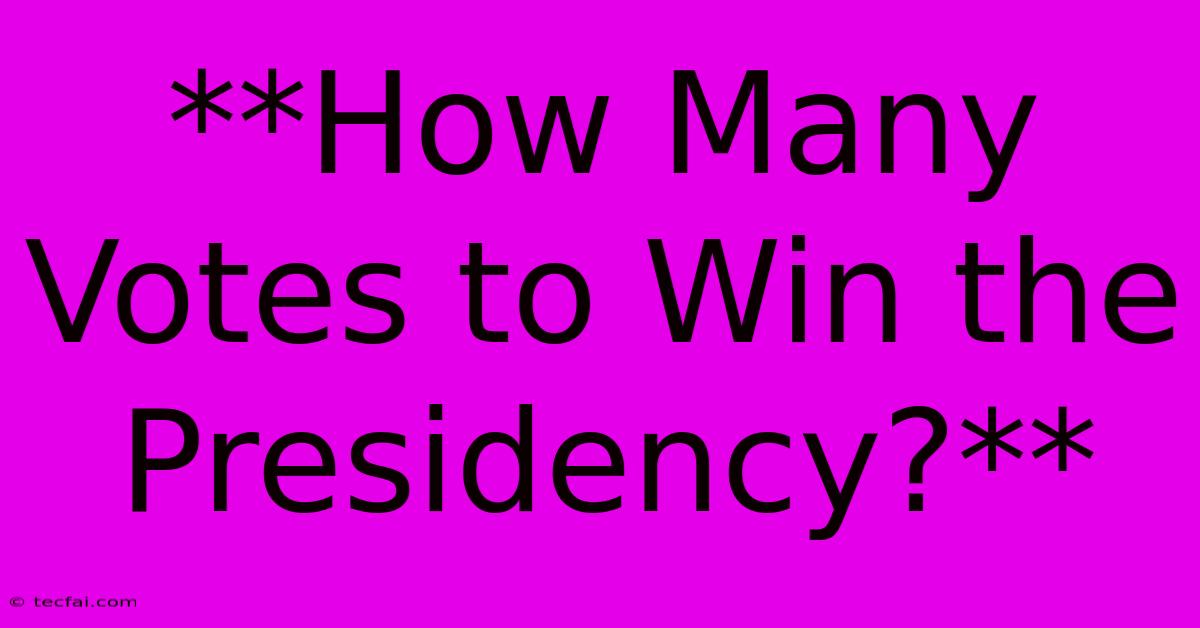**How Many Votes To Win The Presidency?**

Discover more detailed and exciting information on our website. Click the link below to start your adventure: Visit Best Website tecfai.com. Don't miss out!
Table of Contents
How Many Votes to Win the Presidency? Understanding the Electoral College
The United States presidential election is a complex process, and one of the most frequently asked questions is: how many votes does a candidate need to win the presidency? The answer is not as straightforward as it might seem. While the popular vote is important, the Electoral College ultimately determines the winner.
The Electoral College System
The Electoral College is a system established by the U.S. Constitution, where each state is assigned a certain number of electors based on its population. The total number of electors is 538, representing the combined total of senators (100), Representatives (435), and three electors for the District of Columbia.
To win the presidency, a candidate needs to secure a majority of electoral votes, which means at least 270. If no candidate reaches this threshold, the election goes to the House of Representatives.
Understanding How Electoral Votes Work
- Each state's electoral votes are allocated based on its representation in Congress. For example, California, with a large population, has 55 electoral votes, while Wyoming, with a much smaller population, has only three.
- Most states operate on a "winner-take-all" system, meaning the candidate who wins the popular vote in a state receives all of that state's electoral votes.
- The District of Columbia and some states allocate their electoral votes proportionally based on the popular vote results.
Why the Electoral College?
The Electoral College was established by the Founding Fathers as a compromise between those who wanted a popular vote and those who preferred a system that gave more weight to smaller states. It aimed to ensure representation for all states, not just the most populous ones.
Arguments For and Against the Electoral College
The Electoral College has been the subject of much debate over the years. Here are some of the key arguments:
Arguments in favor:
- Protects the interests of smaller states. The system gives each state a minimum number of electors, ensuring that even states with smaller populations have a voice in the presidential election.
- Encourages candidates to campaign in all states. The "winner-take-all" system forces candidates to pay attention to states that might otherwise be overlooked.
- Preserves the federal structure of the United States. The system ensures that the election isn't decided by a few large states, and that all states have a say in the outcome.
Arguments against:
- It's possible to win the presidency without winning the popular vote. This has happened five times in U.S. history, most recently in 2016.
- It discourages voter turnout in states that are considered "safe" for one party or the other.
- It can lead to a situation where the president is elected by a minority of voters.
Conclusion
The Electoral College is a complex and controversial system, and it will likely continue to be debated for years to come. While the popular vote is important, it's ultimately the Electoral College that determines the winner of the presidential election. Understanding the nuances of this system is crucial for anyone wanting to engage in informed political discourse.

Thank you for visiting our website wich cover about **How Many Votes To Win The Presidency?**. We hope the information provided has been useful to you. Feel free to contact us if you have any questions or need further assistance. See you next time and dont miss to bookmark.
Featured Posts
-
Allen Fired Saints Seek New Head Coach
Nov 05, 2024
-
Joe Rogan Supports Trump In Us Race
Nov 05, 2024
-
Warriors Vs Wizards Odds Line Spread
Nov 05, 2024
-
Nfl Trade Deadline Top Rumors And Analysis
Nov 05, 2024
-
When Do Polls Close Us Election Results
Nov 05, 2024
